
What should you do if you see a black spider with white spots on its back? Well, the answer to that question depends on exactly what kind of spider it is. Most peoples’ natural reaction to seeing a spider is one of fear and aversion. These eight-legged arthropods are among the most versatile and diverse groupings of creatures found in the animal kingdom and live on every continent except for Antarctica.
Despite their sinister reputation, most species of spiders are harmless to humans and provide a number of benefits, from eating smaller pests such as flys and mosquitos, the silk they produce, and the potential medicinal properties of their venom. Still, others are of interest to scientists due to the ecological role they play and the complex behavior and hunting strategies they exhibit.
A particularly unique species of spider is the phidippus audux, otherwise known by the name the bold jumping spider. Most commonly found in North America, the bold jumping spider is one of over 6,000 species of spider in the Salticidae family. Though native to temperate grassy areas, human activity has introduced them into more arid desert regions. Fossilized specimens of jumping spiders indicate that the species has been around for at least 42 million years.
“I wish I could have become a spider, then I would have hold you in my web forever.” — Krish
Anatomy and Behavior
The bold jumping spider, as its name would imply, is known for its peculiar habit of jumping around. Most specimens are small, ranging from about 8-19mm for females, and 6-13 mm for males. They are easily identified by the unique white, orange, or yellow patterning on their backs and their iridescent chelicerae (mandibles). The color of the chelicerae are not due to pigment, but due to the reflection of light on tiny scales that line the mandibles. Like all spiders, it has a segmented body with two main parts: a head and a cephalothorax. They have 8 legs, each tipped with an appendage specialized for grasping branches, blades of grass, and prey.
On males, the tufts of hair can sometimes give the appearance of eyebrows. They are most commonly found in open fields, as unlike other spiders, they generally do not build webs to catch food. Instead, they primarily use their jumping ability for hunting, as their quick leaps allow them to sneak up on their prey unnoticed. Phiddipus do however use their silk to create tents to store eggs, protect them when they molt, and provide shelter from rain or other detrimental weather. They also engage in “ballooning,” a common behavior among spiders where they will produce a strand of silk to catch drafts and drift away in the air.

Credit: Pixabay
By altering the pressure of hemolymph (a fluid analogous to blood in vertebrates) in their bodies, they extend their limbs rapidly and use the force to launch themselves into the air. This mechanism is analogous to that found in a hydraulic press, the pressurized liquid expands rapidly and the force straightens the legs and launches the spider into the air. Using their powerful legs, bold jumping spiders can leap a distance of up to 50 times their body length. For reference, that would be the equivalent of an adult human male of average height (5′ 10″) jumping over a football field (~300ft).
Bold jumping spiders have a rather dangerous mating ritual. Males are indiscriminate in their choice of mate, attempting to copulate with any female they come across. Females are larger and more aggressive so the male’s indiscriminate mating can result in them being eaten by the larger female. Male jumping spiders are even known to attempt to mate with spiders of different species, often with unfortunate results. The mating ritual involves a courtship display where the male will display its bright chelicerae and show its colored spots. Like many kinds of spiders, female jumping spiders do not have a specialized opening for insemination. Instead, the male directly injects its semen into the female’s ova by way of a specialed appendage. Females can produce up to 6 clutches of eggs which can each contain anywhere from 30-170 individual eggs. The eggs are laid in the early spring and the newborns emerge by late spring/early summer. The average lifespan of a jumping spider is approximately 1 year.
Eyesight and Spatial Awareness
A unique feature of the bold jumping spider is its sharp eyesight. In particular, the anterior median eyes have very good vision. Anatomical experiments have shown that jumping spiders have up to 4 different kinds of receptor cells and possibly have tetrachromatic color vision, as opposed to trichromatic color vision in humans. Their eyes are too close together to have proper depth perception like humans do, but they make use of a technique known as “image defocusing” to gauge the distance between them and objects in their environment. Incoming green light entering the spider’s anterior median eyes is focused on the deepest layer of the retina, while other layers receive a fuzzy image. By calculating the disparity between the focused and defocused layer, the spider can determine how far away things are in its environment and act accordingly.
Jumping spiders also demonstrates a keen 3-dimensional awareness of their environment and essentially have 360-degree vision. Because they rely on jumping to capture prey, bold jumping spiders must be able to spot their prey, adjust their body accordingly, and determine a possible trajectory before they jump. This sequence of events requires that jumping spiders be able to visualize themselves and their prey in a 3-dimensional space. They also must be able to calculate a specific trajectory for their jump from an extremely large pool of possible trajectories, a computationally very difficult problem. They also have a tendency to fixate on objects and their environment and exhibit a curiosity not seen in other spiders. For example, they will often approach humans rather than scurry away, strange behavior for a spider.
These Spider are Smart
Advanced capacities such as their precise vision and 3-dimensional awareness indicate that bold jumping spiders are capable of complex cognitive tasks. Despite the fact that their brain is the size of a poppy seed, researchers have shown that jumping spiders demonstrate a high level of intelligence not found in other species of spider. A widely referenced study by Robert Jackson and Fiona Cross in the 1980s demonstrated that some subspecies of jumping spider can make and execute complex strategies for hunting. In addition, jumping spiders seem to be able to visualize hidden food and plan a path to get there.
“You don’t work with spiders very long before you start noticing how important silk is to their life and just how special that is for spiders.” — Cheryl Hayashi
In a related 2016 study, Jackson & Cross demonstrated that other subspecies of jumping spiders also exhibit complex planning behavior. In the study, the researchers situated the spiders atop a tower from which they had a view of two separate boxes and two pathways leading to the boxes. One of the boxes contained leaves and the other contained food. After leaving the tower, the spiders were unable to see the boxes and had to choose one of two walkways to reach the box containing food. All 15 species of jumping spider tested chose the correct walkway more often than the incorrect walkway to a statistically significant degree, providing evidence that the spiders were remembering where the box containing food was, even though the box had left their immediate field of vision. Further manipulations showed that even when the spiders initially chose the incorrect path, they would stop and change their movement. The researchers take these findings as evidence that jumping spiders exhibit genuine cognition based on representation. In other words, it seems like the spiders were thinking before acting and were capable of changing plans mid-execution.

In the study, Jackson & Cross distinguish between three different ways that organisms operate in their environment, Darwinian, Skinnerian, and Popperian. Darwinian animals rely on “hardwired” responses to stimuli, while Skinnerian organisms can modulate their hardwired behavior dependent on feedback stimuli from the environment. Popperian animals, on the other hand, are unique in that they can formulate plans ahead of time and act on those plans. The discovery that jumping spiders may fall under the third category of organisms is an exciting prospect and adds to the growing list of evidence of advanced cognition in non-human species.
So what do these spiders mean for humans? Like most species of spider, jumping spiders are non-aggressive so they pose little to no danger to humans unless threatened. Though they technically are venomous, as they use their venom to incapacitate their prey, they very rarely bite. Even if they do, they are unable to administer a large enough quantity of venom to be harmful to humans. Being bitten produces a reaction similar to that of a mosquito bite. In fact, many gardeners are fans of the creatures as they eat up pests that would otherwise ruin crops. So if you see one of these unique creatures in the wild, take a moment to enjoy its affable appearance and behavior, but otherwise leave it be!









